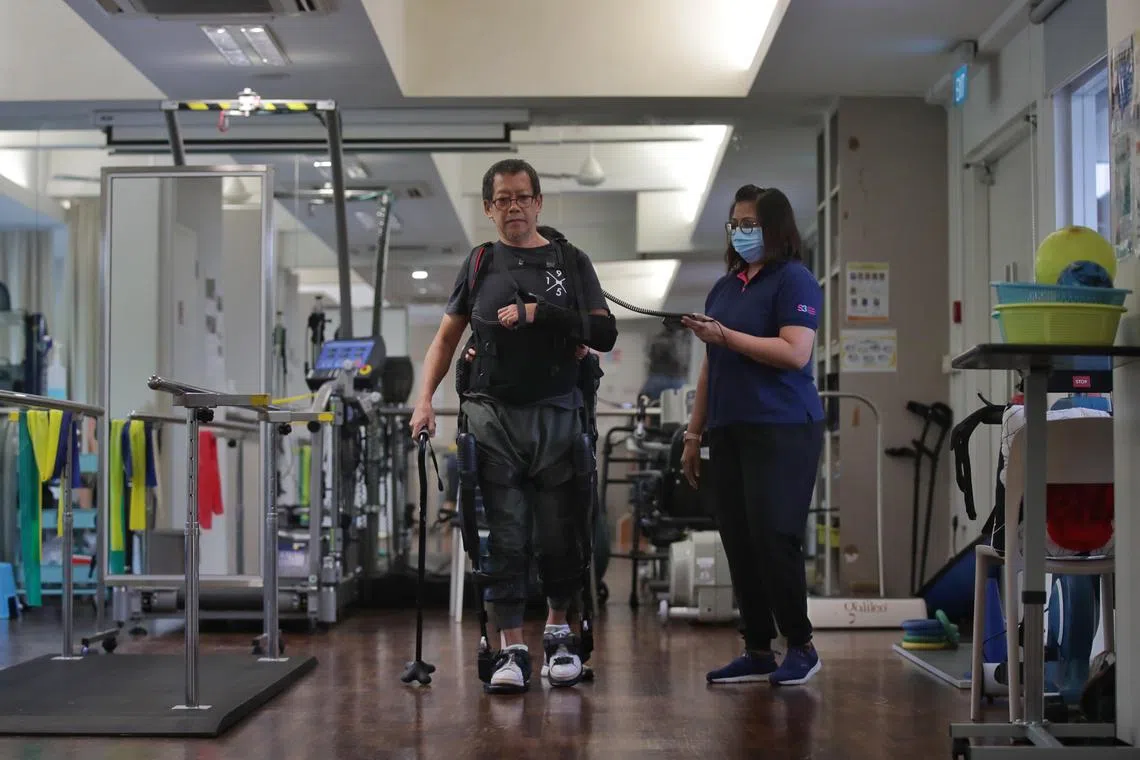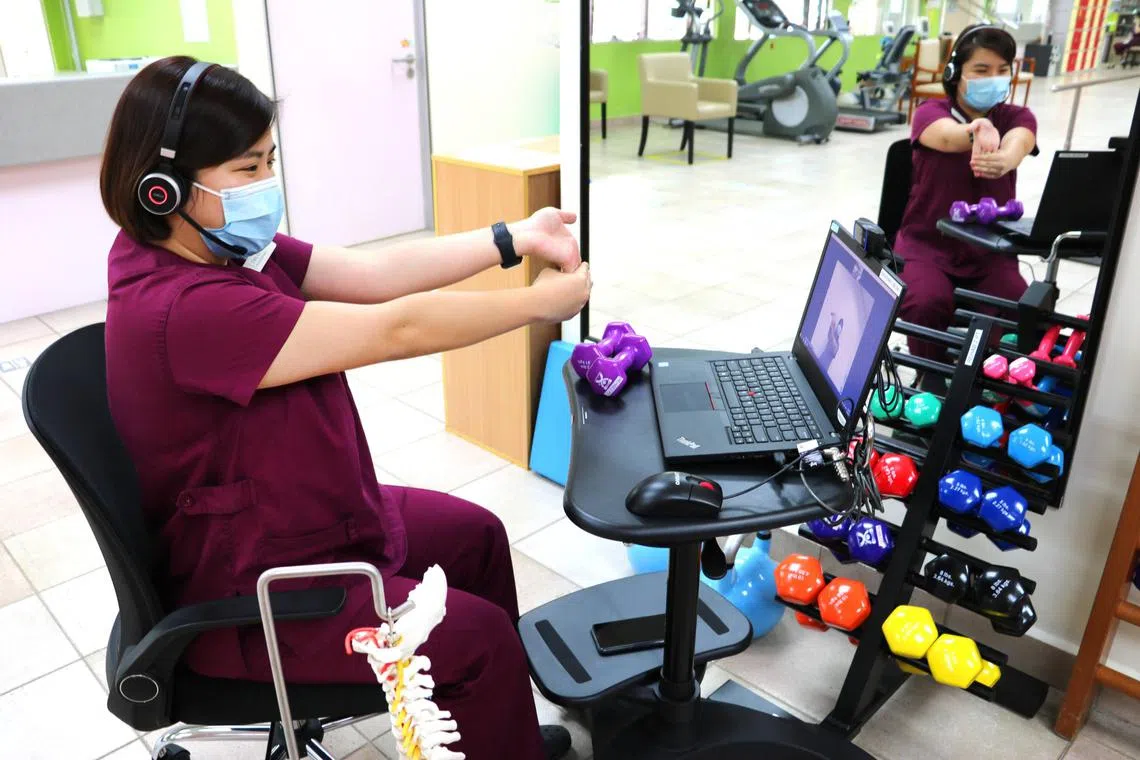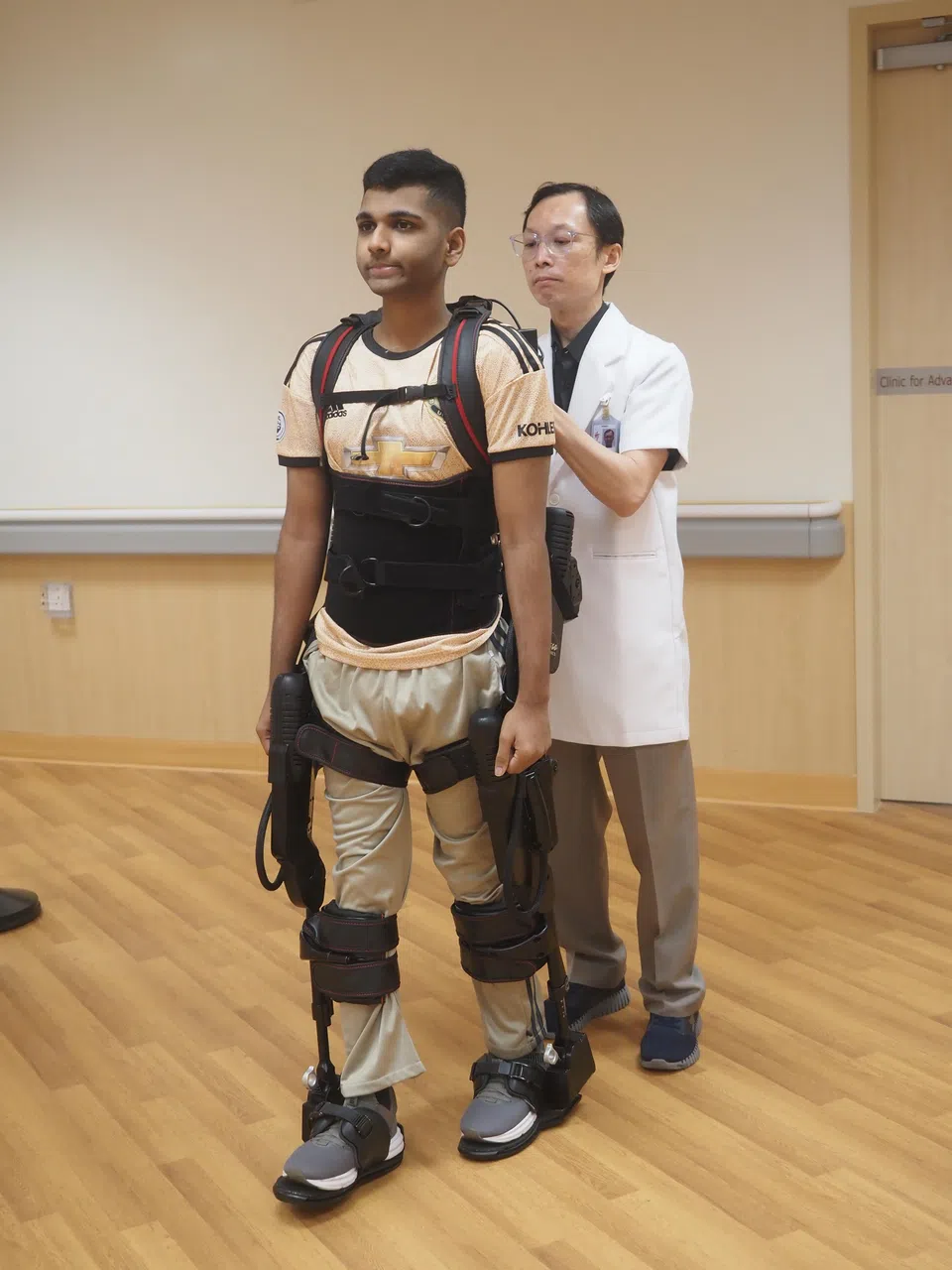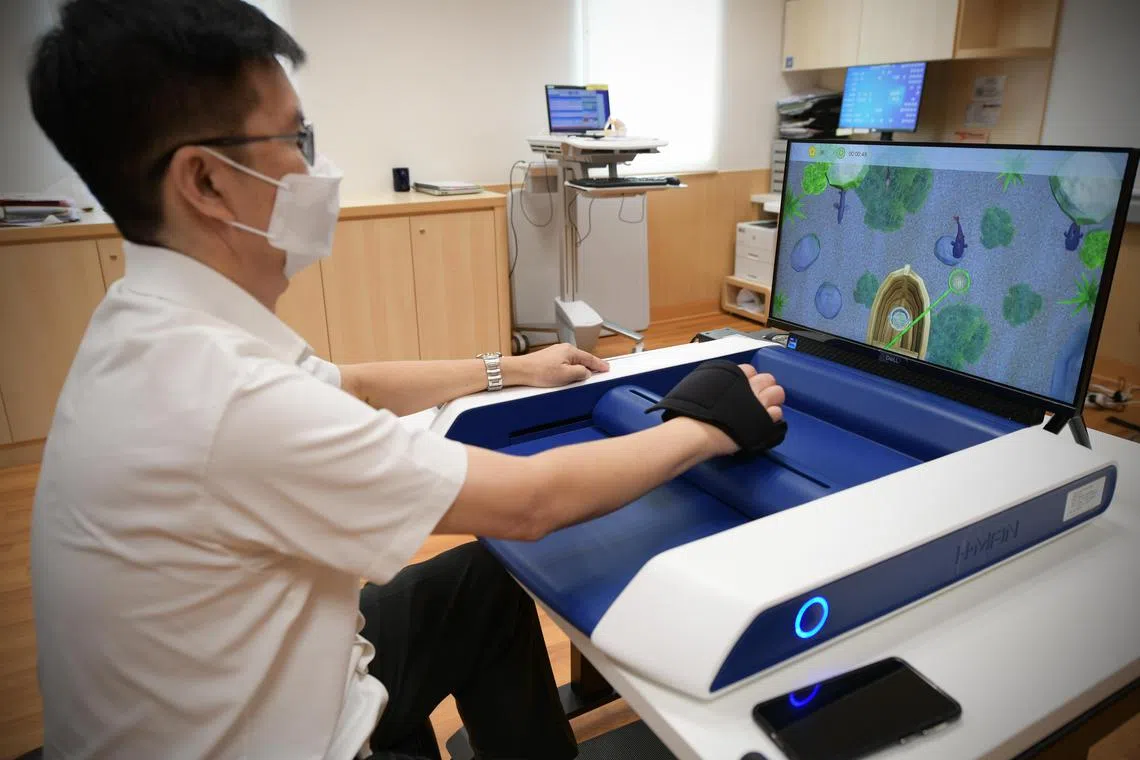Modernising rehabilitation medicine as the sector in Singapore marks golden jubilee
Sign up now: Get ST's newsletters delivered to your inbox

Rehabilitation medicine today is a growing, multidisciplinary field involving healthcare specialists across several domains.
PHOTO: ST FILE
Karen Chua, Loh Yong Joo and Zen Koh
Follow topic:
When 63-year-old Mr Tan had his first stroke, his right side became paralysed, his speech became slurred, and he was unable to rise from his bed.
Rehabilitation therapists arrived the next day at his hospital bedside, helping him as he took his first steps with great difficulty.
Four days later, he was fitted with a powered wearable exoskeleton that protected his body while he walked for 400m under supervision. After five sessions with the exoskeleton, he could walk 1km along the hospital corridors.
A month later, he was discharged and went home, assisted by his wife and a walking cane.
At home, a portable tabletop arm robot aided Mr Tan with exercises for an hour every day to strengthen his weak arm and hand, while video-conferencing software helped with regular speech therapy, which soon improved his communication and fluency.
Three months post-hospitalisation, Mr Tan is able to commute independently on public transport.
Challenges for Singapore’s healthcare
Singapore’s healthcare system will face challenges from a rapidly ageing population.
Each year, around 20,000 people in Singapore suffer from major health conditions such as stroke, heart attack and cancer, which require acute care and rehabilitation to restore them to health through training and therapy.
While the demand for these services is rising, limited capacity in hospital facilities
International studies have shown that at least one in three people would need rehabilitation at some point due to illness or injury. And, with the prevalence of diseases and increasing longevity, there is a pressing demand for new care models which are not only accessible but sustainable.
The ultimate goal is to optimise function and reduce disability in Singapore’s population.
Rehabilitation in Singapore today
In 2023, rehabilitation medicine in Singapore celebrates its golden jubilee.
The nation’s first rehabilitation centre was established in Tan Tock Seng Hospital (TTSH) in Mandalay Road in 1973, before moving to its current premises in Ang Mo Kio in 1994.
From September 2023, its new home will be at the TTSH Integrated Care Hub in Novena.
This is more than a physical move.
Rehabilitation medicine today is a growing, multidisciplinary field involving physicians, therapists, nurses and other healthcare professionals to address complexity across physical, cognitive, behavioural, functional and psychosocial domains.

A leukaemia patient using a robotic exoskeleton for assisted walking at the Clinic for Advanced Rehabilitation Therapeutics (Cart) at Tan Tock Seng Hospital.
PHOTO: ST FILE
The current approach shifts rehabilitation from acute hospitals to dedicated rehabilitation wards in community hospitals, followed by maintenance in day rehabilitation centres.
While this has proven effective in improving patient outcomes, reducing hospital stays and decreasing healthcare costs, rehabilitation still needs to move closer to the community, and even into homes.
Technology has been instrumental in enabling care teams to make rehabilitation more effective and efficient.
We need greater precision to identify each patient’s early potential to better tailor treatments, and to predict outcomes. We need to leverage big data, mobile technology and wearables to allow for the profiling of individual behaviours and responses, and to nudge patients towards positive outcomes.
The shift towards tele-rehabilitation

Alexandra Hospital’s senior physiotherapist Tan Ee Leng demonstrating a wrist-stretching exercise during a virtual consultation with a patient.
PHOTO: ALEXANDRA HOSPITAL
The traditional hospital- or clinic-based rehabilitation model was disrupted during the Covid-19 pandemic, when outpatient services were severely limited.
The rapid deployment and adoption of telemedicine and tele-rehabilitation provide a way to conveniently access therapy sessions from home. This shift from hospital-centred care towards home care allows for decentralisation of services and opens access to high-quality and intensive robot-aided therapy at home.
Portable tabletop upper-limb robots and wearable hand gloves with sensors are already available for home-based training with minimal supervision by carers.
High-tech and high-touch rehabilitation
Robot-aided therapies can safely provide highly intensive, task-orientated and repetitive limb movements. At the same time, virtual reality (VR) systems provide interactive experiences
Patients can train independently within a robotic upper-limb environment. Therapists can further harness motor gains for real-world applications and increase functional independence.
Emerging devices such as wrist-hand neuro-prostheses, wearable powered hand exoskeletons and soft powered gloves allow users to interact with everyday objects.

A patient fitted with an exoskeleton.
PHOTO: NATIONAL HEALTHCARE GROUP
Current lower-limb robots and exoskeletons cater to a wide range of impairments.
These are usually triggered by a patient’s intent to move, promoting longer upright movement and walking times with less fatigue for both patient and therapist. The ability to walk is tripled when such robots are used within three months of a stroke.
Training in VR or immersive virtual environments can activate visual mirror neurons in the brain. VR training can optimise motor learning and enhance neuroplasticity for rehabilitation of stroke, as well as in elderly people who are prone to falls and having poor balance or dementia.
Such rehabilitation technology solutions are already available in Singapore.
The H-Man is a portable robot powered by artificial intelligence (AI), and uses interactive video games to better engage stroke patients in their exercises at home. It was developed by the TTSH Rehab team in collaboration with Nanyang Technological University, and is now offered commercially by a rehab robotics company called Articares.

A stroke patient undergoing therapy using the robot H-Man, which exercises his arm and hand through gameplay.
PHOTO: ST FILE
Similarly, to help patients undergoing rehab at home, Tagglehealth taps existing computer and gaming hardware, and uses psychological sciences in motivation and habits to encourage participation in positive health behaviours.
Fourier Intelligence, in its research partnership with TTSH, leverages advanced robotics and sensor technologies to provide patients with targeted and personalised therapy. For example, its wearable robotic exoskeleton employs advanced sensors and AI algorithms to provide patients with precise assistance during therapy sessions.
While some of these technologies are currently being clinically validated or available via prescription and under professional supervision, they hold much promise for patients to achieve a better quality of life.
Such collaboration between public and private institutions is crucial to innovate rehabilitation programmes that empower patients.
Beyond rehabilitation
A nascent field, regenerative rehabilitation combines the regeneration of new tissue (muscle, bone, nerve or spinal cord) with rehabilitation therapy to optimise recovery. This approach supports the idea that exercise and mechanical stimulation play a role in successful neuro-musculoskeletal regeneration.
A number of local companies are working in related fields.
This includes biotech companies developing cell therapies to restore joint health and function in osteoarthritis, a degenerative and painful joint disease that affects millions worldwide. Another works on 3D-printed bone scaffolds to aid orthopaedic surgery and to help with bone regeneration.
Rebuilding lives though rehabilitation frontier science
The technological advancements in rehabilitation are no longer just laboratory experiments.
The combination of robotics, biotechnology and AI-enabled precision rehabilitation points to a future where patients can optimally recover following major illness or injury. This ongoing partnership between doctors, therapists, scientists, engineers and companies, has led to real-world game changers that transform rehabilitation practice and improve patients’ lives.
Dr Karen Chua is a senior consultant rehabilitation physician at TTSH’s Department of Rehabilitation Medicine and chief clinician at the Rehabilitation Research Institute of Singapore.
Dr Loh Yong Joo is head of and senior consultant at TTSH’s Department of Rehabilitation Medicine.
Mr Zen Koh is the incoming president of the International Industry Society in Rehabilitation Technology and co-founder and global CEO of Fourier Intelligence.

